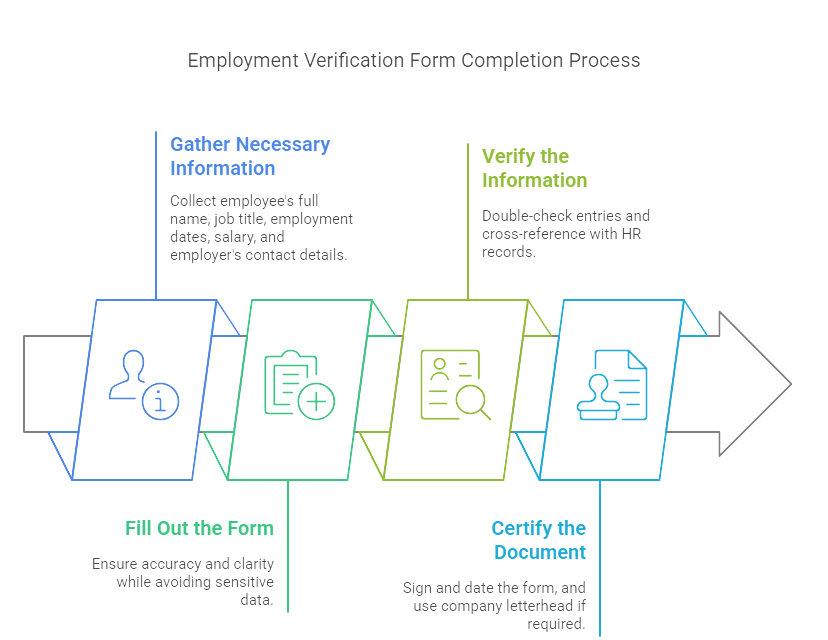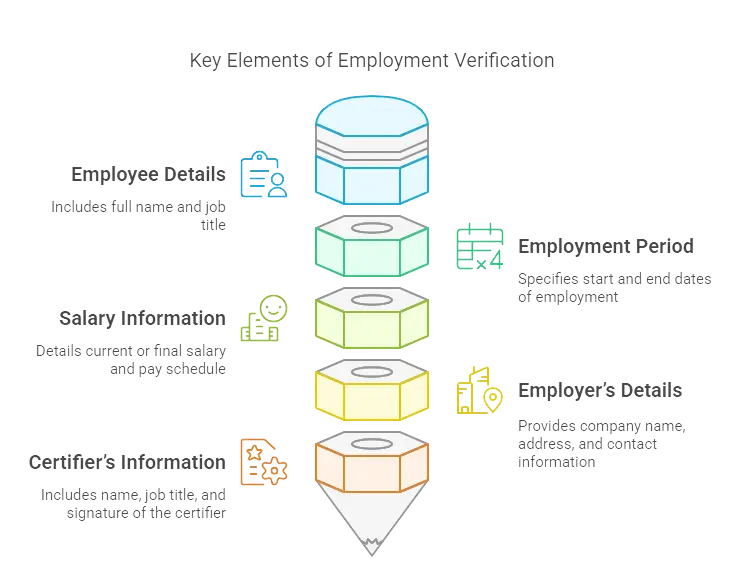In the realm of HR and hiring, a written verification of employment is a critical document. Whether requested by lending institutions, government agencies, or prospective employers, understanding how to accurately and efficiently complete this form is crucial. This guide will walk you through the ins and outs of writing an employment verification form, ensuring that your organization complies with all pertinent regulations while providing clear and accurate information.
Key Takeaways
- A written verification of employment confirms an individual's current or past employment status, including job titles, dates, and salary information.
- Employment verification forms are crucial for loan applications, job offers, and rental applications, providing reliability and proof of employment.
- Accurately completing employment verification forms involves collecting necessary information, ensuring accuracy, and certifying the document with signatures and company letterheads.
- Legal considerations include complying with the Fair Credit Reporting Act (FCRA) and understanding the potential implications of refusing to verify employment.
- Employment verification typically takes a few hours to a couple of days, must come from the employer for credibility, and generally does not incur fees unless the request requires extensive research.
What is a Written Verification of Employment?
A written verification of employment is a formal document confirming an individual's current or previous employment status. It often includes details such as job titles, employment dates, salary information, and other relevant employment data. Such verifications play a significant role in processes like loan applications, background checks, and housing rentals.
It’s pretty straightforward: think of this as providing proof that someone really worked where they said they did, for the amount of time they claimed, and earning what they stated. This document helps banks decide if someone’s financially stable for a loan, assists potential landlords in trusting a tenant’s ability to pay rent, and lets future employers gauge the experience level of an applicant. In essence, it's a factual snapshot of someone's employment journey that can open or close doors to future opportunities.
EXPERT INSIGHT: Let's face it. There are routine tasks in an HR job, and the employment verification process is not an exemption, but there is more than paperwork to fill. With every request for verification, an individual is seeking a new home, an approved loan, or a secured job that can change the trajectory of their life. In this process, keenness to data and a compassionate heart matter. The step-by-step process may seem routinary, but as an HR professional with first-hand experience, I can say that employment verification is not just a compliance exercise. It is an opportunity to uphold integrity, establish trust, and support an individual's new journey. - Charm Paz, CHRP
Why Is an Employment Verification Form Important?
Employment verification forms serve multiple purposes:
- Loan Applications: Lenders use this information to evaluate a borrower’s financial stability. Banks and mortgage companies need assurance that the applicant is securely employed, enabling them to assess the risk of lending money.
- New Job Offers: Prospective employers verify past employment to confirm experience and reliability. It’s a way to corroborate a candidate's resume claims and ensures they have the work history and skills for the new role.
- Rental Applications: Landlords may request an employment verification to ensure a tenant’s ability to pay rent. This is a common practice to gauge whether a potential renter has a steady income stream, reducing the risk for the property owner.
Accurate and timely completion of these forms is essential to facilitate these various processes, ensuring all parties involved can make informed decisions based on reliable information.
How to Complete an Employment Verification Form
Step-by-Step Guide
1. Gather Necessary Information
- Employee's Full Name: Ensure you have the correct spelling of the employee's first and last names.
- Job Title: Record the employee's official job title as it appears in your HR records.
- Employment Start and End Dates (if applicable): Note the exact dates the employee started and ended their employment, or mark "Present" if they are still employed.
- Salary Information: Include the employee's current or most recent salary, and note whether it is on an annual, monthly, or hourly basis.
- Employer's Contact Details: Provide the company name, address, and a contact number for verification purposes.
2. Fill Out the Form
- Accuracy is Key: Verify that all information entered is correct. Typos or misinformation can cause delays.
- Clarity and Conciseness: Use straightforward language. Avoid jargon and unnecessary details that could confuse the recipient.
- Limit Sensitive Data: Only provide the information explicitly requested. Avoid including unnecessary personal details that could compromise the employee's privacy.
3. Verify the Information
- Double-Check Entries: Go over all fields to confirm the information is accurate. Errors can lead to repeated requests and processing delays.
- Cross-Reference HR Records: Validate information against the employee's official records. Ensure consistency across all internal documentation.
4. Certify the Document
- Sign and Date: A signature from an authorized company representative, along with the date, authenticates the form.
- Company Letterhead: If required, print the verification on official company letterhead for further legitimacy.

Example Form
[Company Letterhead]
Date: ___________
To Whom It May Concern,
This letter is to verify that [Employee’s Full Name] is/was employed at [Company Name] from [Start Date] to [End Date, if applicable]. [He/She] currently holds/held the position of [Job Title]. [Employee’s Full Name] earns/earned a salary of [Salary Information] per [Year/Month/Week].
If you have any further questions or need additional information, please do not hesitate to contact me at [Your Contact Information].
Sincerely,
[Your Name]
[Job Title]
[Signature]
By following these straightforward steps, you can ensure that your employment verification forms are accurate, clear, and compliant. This will not only help your former and current employees but also reinforce your company's reliability in its external engagements.
What Should Be Included in an Employment Verification Form?
When drafting an employment verification form, it’s important to include specific information to ensure the recipient gets a comprehensive view of the employee's work history and current status. Here’s a rundown of the key elements you should always incorporate:
- Employee Details: Start with the basics. Include the employee's full name and their job title. This ensures that there’s no ambiguity about whose employment is being verified and in what capacity.
- Employment Period: Clarify the duration of the employee's tenure at your company. This includes the start date and, if applicable, the end date of employment. This information helps lenders, prospective employers, or landlords gauge the employee's stability and work history.
- Salary Information: Include the current or final salary of the employee. Depending on the request, you might also need to provide information on their pay schedule—whether it’s per year, month, or hour. If requested, include any pertinent details about bonuses or additional compensation.
- Employer’s Details: Provide comprehensive information about the company. This includes the company name, its physical address, and contact information. This section validates that the employee worked (or works) at a legitimate business.
- Certifier’s Information: This includes the name and job title of the person completing the verification. A signature is typically required for authenticity. Including contact details of the certifier adds an extra layer of credibility and allows the recipient to follow up if needed.
By ensuring all these components are clearly and accurately included, you provide a robust and reliable employment verification form that meets the needs of any requesting party and facilitates smoother processes for the employee.

Legal Considerations
Can an Employer Refuse to Verify Employment?
While it's uncommon, some employers might choose to decline verification of employment for a variety of reasons, such as strict company policies or legal concerns. However, keep in mind that refusing to provide verification can have significant ramifications for the employee, including difficulties in securing loans, rental agreements, or new job opportunities. If your company has such a policy, it's often beneficial to review it with your HR department or seek legal guidance to understand potential impacts and alternatives.
What Are the Legal Implications?
Compliance is key when handling employment verification forms. Ensure that these verifications align with regulations such as the Fair Credit Reporting Act (FCRA) and other pertinent laws. Misrepresentation or providing inaccurate information can lead to legal disputes and damage the company’s reputation. Consequences could include fines, lawsuits, and a loss of trust in your organization. For thorough guidelines, refer to resources like the Federal Trade Commission’s guidance on background checks or consult legal experts to make sure you’re on solid ground.
Frequently Asked Questions
How Long Does an Employment Verification Take?
Typically, processing an employment verification can take anywhere from a few hours to a couple of days, depending on the company's verification procedures and responsiveness.
Can You Verify Employment Yourself?
Self-verification is not considered valid for official purposes. Verification must come from the employer to be accepted by external entities.
What Should I Do If My Employer Refuses to Verify Employment?
If your employer refuses to provide employment verification, it’s best to discuss the issue with your HR department to understand the reasons behind the refusal. Sometimes, employers may have specific policies or legal reasons for not providing verification. If internal resolution fails, you may need to seek legal advice to understand your rights and potential actions you can take.
Is Salary Information Mandatory to Include?
Salary information is generally required by lenders, landlords, and some potential employers to assess financial stability. However, be sure to disclose this information only to authorized and legitimate entities to protect the employee’s privacy.
Can Previous Employers Be Contacted Without Permission?
Usually, current or former employees should provide authorization for third parties to contact their previous employers. This helps ensure privacy and compliance with various privacy regulations.
Are There Any Fees for Employment Verification?
Most companies provide employment verification free of charge, but some might charge a nominal fee, especially if the request requires extensive research or documentation. Always check with your HR department for any applicable fees.
Keeping these aspects in mind, employers can navigate the employment verification process efficiently, ensuring both compliance and employee satisfaction.
Conclusion
Employment verification forms are a staple in the HR toolkit, providing necessary confirmations for various purposes, from loans to new job offers. Ensuring these forms are accurately completed, legally compliant, and timely can prevent delays and legal complications.
By following the steps outlined in this guide, employers can provide efficient and accurate verifications that meet all necessary criteria. For further assistance with employment verification or background checks, don’t hesitate to consult the resources available through HR platforms and legal guidelines.
Understanding and correctly executing employment verification ensures compliance and aids in maintaining a positive reputation for your organization. This mindful approach not only streamlines operations but also fosters trust and reliability between employers and external entities like financial institutions or prospective landlords.
Still have questions?
Get in touch with our team today for a personalized demo and discover how our tailored volume pricing and packages can drive results for your business!
How useful was this page?*
Note: your comments are anonymous. We use them to improve the website. Do not include any personal details.
Visit our FCRA Compliance Tool or leave a message here if you need a response.
From the blog Explore the GCheck Content Hub

Level 2 Background Check: 2026 Guide for HR Professionals
7 Jan, 2026 • 22 min read
What Does an SSN Trace Show? 2026 Guide for Employers and Job Seekers
7 Jan, 2026 • 22 min read
How to Dispute a False Positive Drug Test in 2026: Guide for Employers and Employees
6 Jan, 2026 • 22 min readThe information provided in this article is for general informational and educational purposes only and should not be construed as legal advice or a substitute for consultation with qualified legal counsel. While we strive to ensure accuracy, employment screening laws and regulations—including but not limited to the Fair Credit Reporting Act (FCRA), Equal Employment Opportunity Commission (EEOC) guidelines, state and local ban-the-box laws, industry-specific requirements, and other applicable federal, state, and local statutes—are subject to frequent changes, varying interpretations, and jurisdiction-specific applications that may affect their implementation in your organization. Employers and screening decision-makers are solely responsible for ensuring their background check policies, procedures, and practices comply with all applicable laws and regulations relevant to their specific industry, location, and circumstances. We strongly recommend consulting with qualified employment law attorneys and compliance professionals before making hiring, tenant screening, or other decisions based on background check information.


